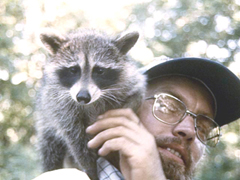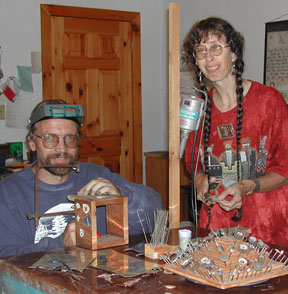| |
|
|
Bearpaw Jewellery - 705-645-4167
E-mail
Peter
Jessen's work as a Jeweller is
a journey of inspiration and growth. The subjects
of his art are found right outside of his workshop
window, overlooking a beaver pond amidst the Canadian
bush and all its wild inhabitants. Many of these
naturally drift up to the house presenting themselves
as new inspirations to be transformed into wearable
archetypal art .
In
his free time Peter loves to read, hike into the bush,
canoe, observe wildlife and meet with friends. His
main interests are Anthropology, Pre-history and most
of all Rupestrian Art = Petroglyphs and Pictographs
from around the world. All of these interests are sources
of inspiration for Peter's art. |
 |
Mi-Shell
Jessen is probably best known as
one half of Bearpaw Jewellery, but primarily, she
works as a shaman / healer in Muskoka and Southern
Ontario. She is a Registered Nurse and a Jungian
Therapist by training, but, first and foremost,
she is following in the footsteps of her grandmother,
the healer-shaman of her tribe, the Urianshai,
in Siberia.
Mi-Shell
has practiced, taught and used shamanism and shamanic
healing pathways with her patients, clients, in schools,
Pow Wows and the health care system. She
leads circles and gatherings that focus on teaching,
healing, ritual, drums and drumming, human growth and
well-being.
Bearpaw
Jewellery is a means for her to translate the mysteries
experienced in trance and visions into tangible reality
and to share it all with her community. Her shamanic
Medicine pouches, ritual tools and other mixed media
art are unique and sought after by collectors.
One
of the most important tools of a Medicine Woman is
the drum, the heartbeat of Mother Earth and the heartbeat
and voice of our soul. Mi- Shell creates drums and
leads the weekly local community drum circle as well
as several frame drum circles. |
 |
 |
|
The
Importance of Place, Living Gently in Nature
By GERALD ALLABY
“We
live out here in nature, In as perfect a biosphere as is
possible."
Peter
and Mi-Shell Jessen are explaining to me the importance
of place in the philosophy of their art and their life.
I look
out the studio window towards Echo Creek and the 100 acres
of swamp, trees and blueberry bushes beyond. Hordes of mosquitoes
buzz outside the window. A hummingbird darts away from a
feeder .
" When
we came here we changed the environment as little as possible," Mi-Shell
continues. "We understood that nature is food for
the soul. It feeds our creative energies. If we didn't
have this (she gestures through the studio window), we
couldn't make jewellery as we do. What is out there is
inside us."
It is
what the Jessens refer to as a "pattern of balance in
life", their work expressive of the continuum, "the
circle" of existence of which humanity is but a part.
" Nature
is beauty, a place of transformations - animal, spirit,
human. To destroy nature is to destroy the circle. We must
not destroy nature but honour it," Mi-Shell says.
The Jessens
live in a log home in the woods beyond Fraserburg. They came
here more then 15 years ago, cleared a space, built the home
themselves. It is still a work in progress. It is also a
home among many homes here.
" Over
there lives Windwalker ," Mi-Shell says by way of
explanation. She is talking of a black bear that is their
neighbour. Windwalker
is one of the animal images that are intrinsic in the design
of their jewellery .
They call
their business Bearpaw Jewellery. They specialize in original
designs based on the wildlife around them, reinterpreted
and activated through their study of native and pre-Christian
mythologies.
In the
wood pile under the deck a raccoon named Hairdresser, because
of her propensity for hair grooming, has made her den and
is raising her young. In a box in the living-room, a baby
raccoon they are nursing lies asleep, a victim of a motorist
that killed his mother and four siblings.
He was
found in a ditch and brought to them for care. If he survives
I am told they will call him Lucky. (Two days later I did
receive an e-mail confirming his naming, signed "Lucky".)
" Each
face, each animal has to be named," Mi-Shell says. “This
builds a personal bond. When we sell a piece of jewellery
we insist the buyer give it a name,because that builds a personal
connection with the piece."
This process gives
the jewellery piece a story, which gives it life.
And Mi-Shell is a born story-teller. Part of her approach is to tell to potential
clients those stories, from lore or legend, that inspired the creation of a
piece of jewellery.
Trained as a psychiatric nurse, she first made bead jewellery as a hobby and
used it in therapy for clients coming to her clinic in Germany. It was at this
time she discovered she "saw things doctors didn't", premonitions
which a shaman later told her gave her a special power as a medicine woman.
In some
ways this did not, of course, surprise Mi-Shell. "I
come from a gypsy heritage," she says simply. She grew
up in a Bavarian castle. Her father survived in the underground
that fought Hitler. Her mother, interned in a camp, survived
the Holocaust.
"Early
I realized," she says, "I could communicate with
nature." She found all things in nature had a story
to tell, had a spirit that when listened to enhanced her
being and understanding.
"The
wolf, for example, expresses the spirit of endurance and
survival; the bear is a spiritkeeper that suggests goodness,
strength and knowledge of self."
The Jessens
came here from Germany. They settled in Muskoka in the late
1980s after several years of travelling across North America
in the old yellow Volkswagen van that sits just outside their
door. They made jewellery along the way to support themselves.
"We
went to the Northwest Territories, the Yukon, Alaska.
We spent our winters in Florida. Once we went to Labrador
City, driving there before the road was built," Peter
says. "We travelled along the railway line.
"When
we arrived we were greeted with astonishment and they held
a flea market just so we could sell them our jewellery
for Christmas gifts."
For Peter
and Mi-Shell, life is a journey and their work expresses
the gifts of that journey's experiences: They seek in their
work those patterns of balance in life that tell us those
stories essential to an understanding of our existence and
our place in nature.
In their work they use the "materials of nature": bone, antler, metals,
wood, stone. Even the resins and colours used for inlay enamel come from natural
sources.
While
the "instinct" for a design comes through Mi-Shell's
contemplation of nature and study of myth and folklore, it
is Peter who is the technician, whose ability to manipulate
objects from nature into intricate pieces,
Mi-Shell says, "comes
from deep inside."
While many of their designs derive from Native imaging, especially from petroglyphs,
the work does not directly appropriate Native culture. Rather, the work expresses
visually the "collective unconscious", that part of the "original
memory inside us all that we can apprehend if we clear out modern, especially
religious, beliefs and prejudices." We are all the children of Lucy," Mi-Shell
says in conclusion, a reference,to the name given to the earliest humanoid
creature known. "We all share our genes with Lucy. We all come from the
same source."
THE
ARTISTS | GALLERY | STUDIO | SHOWS | SHAMANIC
TEACHINGS | LEGENDS | LINKS | HOME |
|
